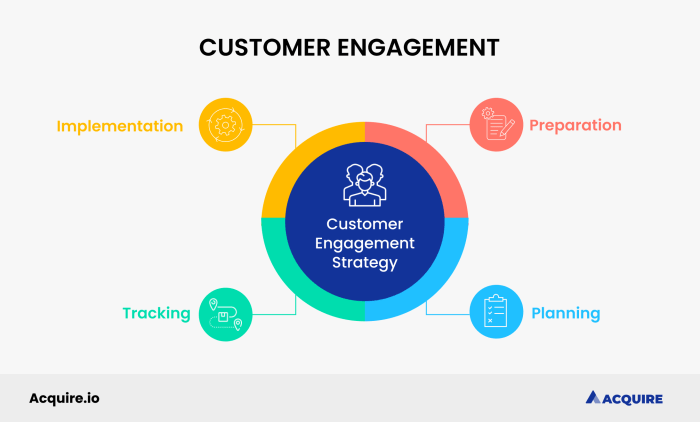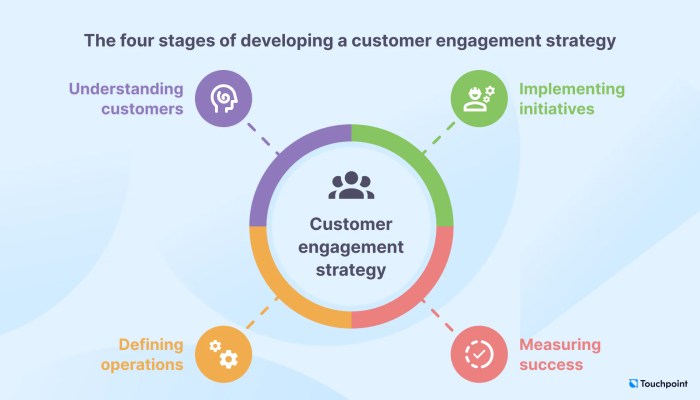Developing a Customer Engagement Strategy is the key to unlocking success in today’s competitive business landscape. By understanding your audience, leveraging various engagement channels, personalizing interactions, and measuring success, businesses can create lasting relationships with their customers. Let’s dive into the world of customer engagement strategy and discover how it can revolutionize your business approach.
Importance of Customer Engagement Strategy
Having a well-developed customer engagement strategy is crucial for businesses to build strong relationships with their customers, increase brand loyalty, and drive repeat sales. It involves interacting with customers through various channels to understand their needs, gather feedback, and provide personalized experiences.
Examples of Successful Companies
- Apple: The tech giant has a loyal customer base that eagerly anticipates new product releases and engages with the brand through online communities and events.
- Starbucks: The coffee chain has created a successful customer loyalty program, rewarding frequent customers with discounts and personalized offers.
- Zappos: The online retailer is known for its exceptional customer service, engaging with customers through social media, live chat, and phone support.
Increased Customer Loyalty and Retention
A good customer engagement strategy can lead to increased customer loyalty and retention by making customers feel valued and appreciated. When businesses actively listen to their customers, address their concerns, and provide personalized experiences, customers are more likely to continue doing business with them. This can result in higher customer lifetime value and positive word-of-mouth referrals.
Understanding Your Target Audience
When developing a customer engagement strategy, it is crucial to understand your target audience. This knowledge allows businesses to tailor their approach, communication, and offerings to meet the specific needs and preferences of their customers.
Importance of Understanding Your Target Audience, Developing a Customer Engagement Strategy
Analyzing and segmenting your target audience can be done through various methods such as demographic data, psychographic information, and behavioral patterns. By understanding these aspects, businesses can create detailed customer profiles and identify different segments within their target audience.
- Demographic Data: Businesses can analyze information such as age, gender, income level, education, and location to understand the basic characteristics of their target audience.
- Psychographic Information: This involves looking at the lifestyle, values, interests, and attitudes of customers to gain insights into their motivations and preferences.
- Behavioral Patterns: By examining purchasing behavior, brand interactions, and engagement levels, businesses can understand how customers interact with their products or services.
Examples of Tailored Customer Engagement Strategies
| Business | Target Audience Demographics | Tailored Strategy |
|---|---|---|
| Apple | Youthful, tech-savvy individuals | Engages with customers through sleek design, innovative technology, and creative marketing campaigns targeting a younger audience. |
| Lululemon | Active, health-conscious consumers | Focuses on community-building, wellness events, and personalized recommendations to connect with their fitness-oriented target audience. |
| Dove | Women of all ages, body-positive advocates | Empowers women through inclusive marketing campaigns, diverse representation, and messages promoting self-confidence and acceptance. |
Channels for Customer Engagement
In today’s digital age, businesses have a plethora of channels at their disposal to engage with customers and build lasting relationships. These channels serve as the bridge between the brand and the consumer, allowing for meaningful interactions and feedback exchange.
Social Media
Social media platforms such as Facebook, Instagram, Twitter, and LinkedIn offer businesses a direct line of communication with their target audience. By creating engaging content, responding to comments and messages, and running targeted ad campaigns, businesses can effectively engage with customers on social media.
Email Marketing
Email marketing remains a powerful tool for customer engagement, allowing businesses to send personalized messages, promotions, and updates directly to their customers’ inboxes. By segmenting their email lists and crafting compelling content, businesses can drive customer engagement and loyalty through email campaigns.
Live Chat
Live chat support on websites offers customers instant access to assistance and information, enhancing their overall experience. By providing real-time support and personalized recommendations, businesses can engage with customers in a more interactive and immediate way, addressing their needs and concerns promptly.
Choosing the Right Channels
When selecting customer engagement channels, businesses must consider their target audience’s preferences and behaviors. By analyzing data and feedback, businesses can determine which channels are most effective for reaching their customers and achieving their business goals. It’s essential to tailor the approach to each channel based on the audience’s expectations and engagement patterns.
Personalization in Customer Engagement: Developing A Customer Engagement Strategy

Personalization plays a crucial role in customer engagement strategies as it allows businesses to tailor their interactions with customers based on individual preferences, behaviors, and needs. This leads to more meaningful and relevant engagements, ultimately fostering stronger relationships and increasing customer loyalty.
Examples of Personalized Customer Engagement Tactics
- Customized recommendations based on past purchases or browsing history.
- Personalized email campaigns addressing customers by name and offering targeted promotions.
- Interactive content experiences that adapt to user preferences in real-time.
Leveraging Data and Technology for Personalization
Businesses can harness the power of data and technology to personalize customer interactions in various ways:
- Utilizing customer relationship management (CRM) systems to track customer preferences and behavior.
- Implementing artificial intelligence (AI) algorithms to analyze data and provide personalized recommendations.
- Leveraging customer data platforms (CDPs) to create unified customer profiles for more targeted engagement.
Measuring Success and KPIs

To determine the effectiveness of a customer engagement strategy, businesses need to track key performance indicators (KPIs) that measure various aspects of customer interaction and satisfaction. By analyzing these metrics, companies can optimize their efforts to better engage with their target audience.
Key Performance Indicators (KPIs)
- Customer Satisfaction Score (CSAT): This metric gauges how satisfied customers are with their overall experience. It is usually measured through surveys or feedback forms.
- Net Promoter Score (NPS): NPS measures customer loyalty by asking customers how likely they are to recommend the company to others. It helps in understanding brand advocacy.
- Customer Retention Rate: This KPI indicates how successful a company is at retaining customers over a specific period. A high retention rate signifies strong customer engagement.
Importance of Tracking and Analyzing Metrics
Tracking and analyzing metrics is crucial for businesses to identify areas of improvement in their customer engagement strategy. By monitoring KPIs regularly, companies can make data-driven decisions to enhance customer experience and increase loyalty. It also helps in understanding customer preferences and behavior patterns.
Tools and Software for Tracking Customer Engagement Metrics
- Google Analytics: This tool provides valuable insights into website traffic, user behavior, and conversion rates, helping businesses understand customer engagement levels.
- CRM Systems: Customer Relationship Management systems like Salesforce or HubSpot offer features to track customer interactions, sales, and marketing efforts for improved engagement.
- Social Media Analytics: Platforms like Facebook Insights, Twitter Analytics, and LinkedIn Analytics help businesses analyze engagement metrics on social media channels.
